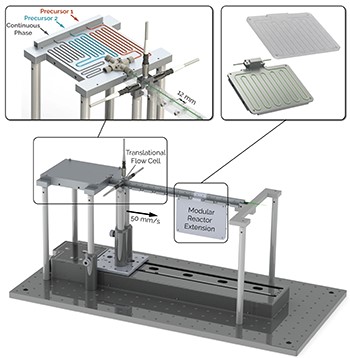Abolhasani Group Advances Understanding of Nanocrystal Synthesis
 Professor Milad Abolhasani and his research group have developed a device that allows users to collect 100 times more information per day from microfluidic devices, devices that manipulate fluids at the micron-scale, as compared to the previous industry standard. The information is spectrographic fluorescent and absorption data of samples in the device they designed and fabricated.The novel technology has already led to a new discovery: the speed of mixing ingredients for quantum dots (nanoscale semiconductor particles) used in LEDs changes the color of light they emit – even when all other variables are identical.m
Professor Milad Abolhasani and his research group have developed a device that allows users to collect 100 times more information per day from microfluidic devices, devices that manipulate fluids at the micron-scale, as compared to the previous industry standard. The information is spectrographic fluorescent and absorption data of samples in the device they designed and fabricated.The novel technology has already led to a new discovery: the speed of mixing ingredients for quantum dots (nanoscale semiconductor particles) used in LEDs changes the color of light they emit – even when all other variables are identical.m
“Semiconductor nanocrystals are important structures used in a variety of applications, ranging from LED displays to solar cells. But producing nanocrystalline structures using chemical synthesis is tricky, because what works well on a small scale can’t be directly scaled up – the physics don’t work,” says Professor Abolhasani, corresponding author of a paper on the work.
“This challenge has led to an interest in continuous nanomanufacturing approaches that rely on precisely controlled microfluidic-based synthesis,” Abolhasani says. “But testing all of the relevant variables to find the best combination for manufacturing a given structure takes an extremely long time due to the limitations of the existing monitoring technologies – so we decided to build a completely new platform.”
Currently, microfluidic monitoring technologies are fixed in place and measure either absorption or fluorescence. Fluorescence data tell you what the crystal’s emission bandgap is – or what color of light it emits – which is important for LED applications. Absorption data tell you the crystal’s size and concentration, which is relevant for all applications, as well as its absorption bandgap – which is important for solar cell applications.
To measure both fluorescence and absorption you’d normally need two separate monitoring points. And with the monitors fixed in place, researchers would speed up or slow down the flow rate in the microfluidic channel to control the reaction time of the chemical synthesis: the faster the flow rate, the less reaction time a sample has before it hits the monitoring point. Working around the clock, this approach would allow a lab to collect about 300 data samples in 24 hours.

Abolhasani and his team developed an automated microfluidic technology, the NanoRobo, in which a spectrographic monitoring module that collects both fluorescent and absorption data simultaneously moves along the microfluidic channel, collecting data along the way. The system is capable of collecting 30,000 data samples in 24 hours – expediting the discovery, screening, and optimization of colloidal semiconductor nanocrystals, such as perovskite quantum dots, very small semiconductor particles only a few nanometers in size.
The translational capability of the novel monitoring module enables the system to measure reaction time by moving along the microfluidic channel, rather than by changing the flow rate – which, the researchers discovered, makes a big difference.
Because NanoRobo allows researchers to monitor reaction time and flow rate as separate variables for the first time, Abolhasani was the first to note that the velocity of the samples in the microfluidic channel affected the size and emission color of the resulting nanocrystals. Even if all the ingredients were the same, and all of the other conditions were identical, samples that moved – and mixed – at a faster rate produced smaller nanocrystals. And that affects the color of light those crystals emit.
“This is just one more way to tune the emission wavelength of perovskite nanocrystals for use in LED devices,” Abolhasani says.
NC State has filed a provisional patent covering NanoRobo and is open to exploring potential market applications for the technology.
The paper, “Automated microfluidic platform for systematic studies of colloidal perovskite nanocrystals: towards continuous nano-manufacturing,” is published in the journal Lab on a Chip, as part of its Emerging Investigators series. Lead author of the paper is Robert Epps, a CBE graduate student. The paper was co-authored by Kobi Felton, a CBE undergraduate, and Connor Coley, a graduate student at MIT. The work was done with support from NC State and the UNC Research Opportunities Initiative.
The original article was written by Matt Shipman, Research Lead in University Communications at NC State.